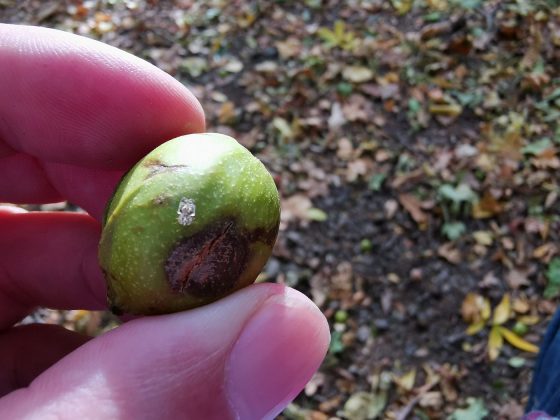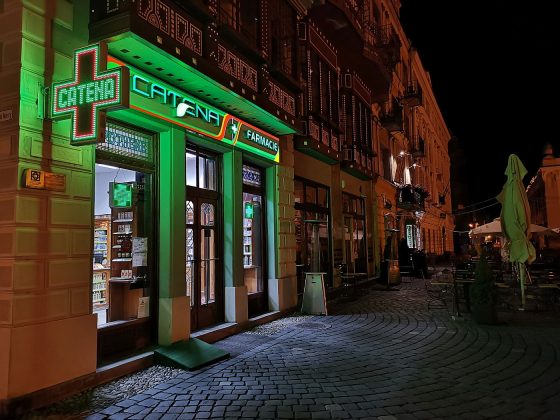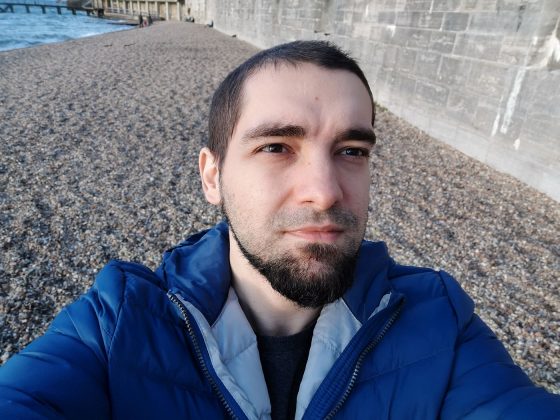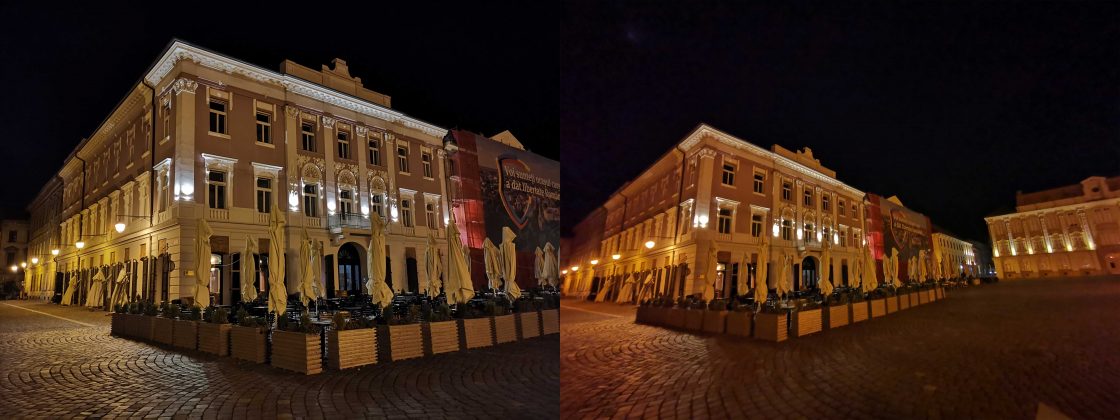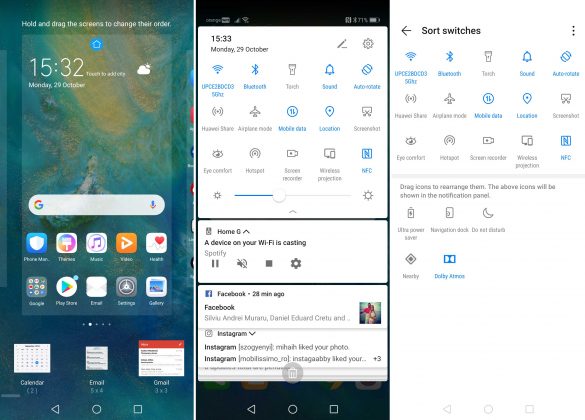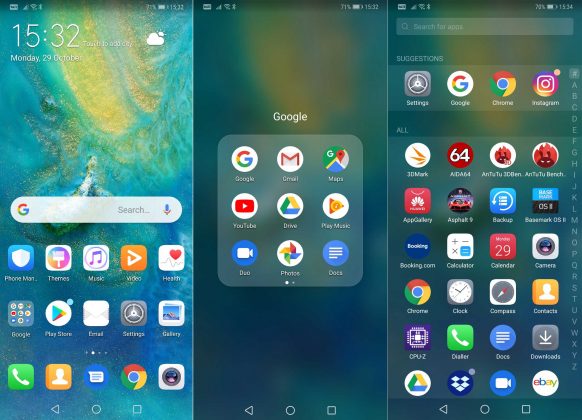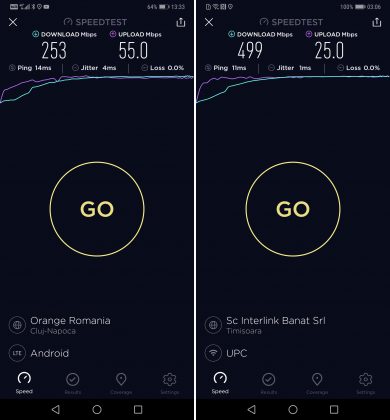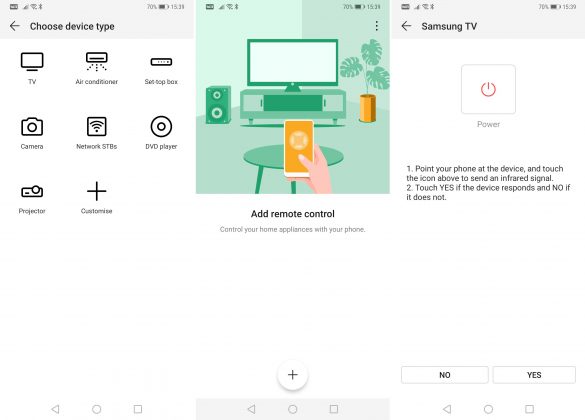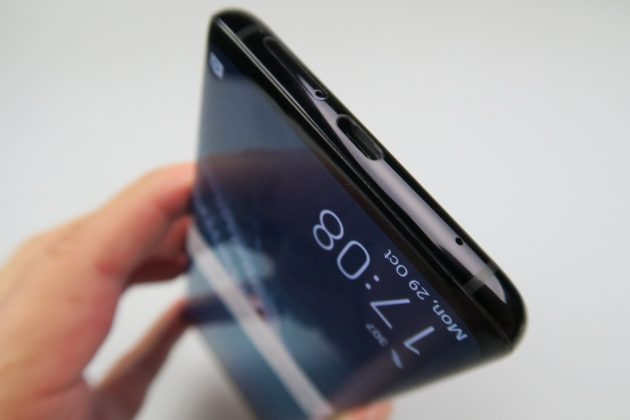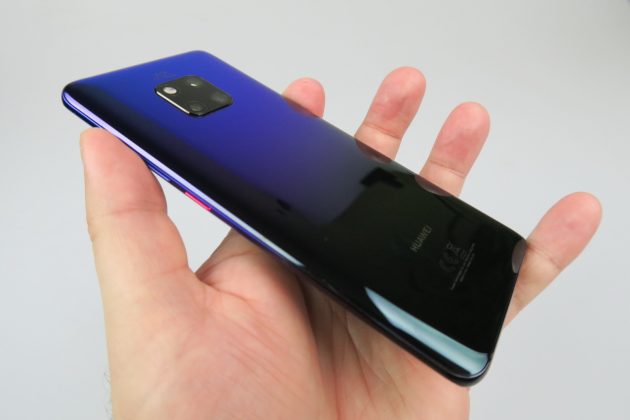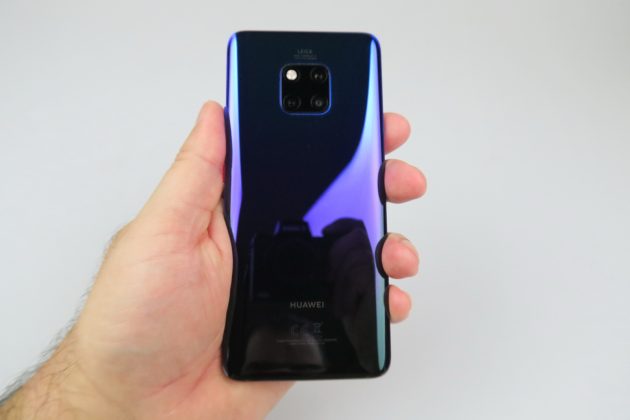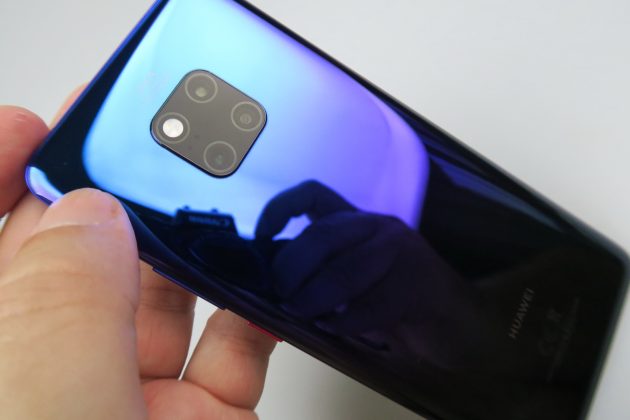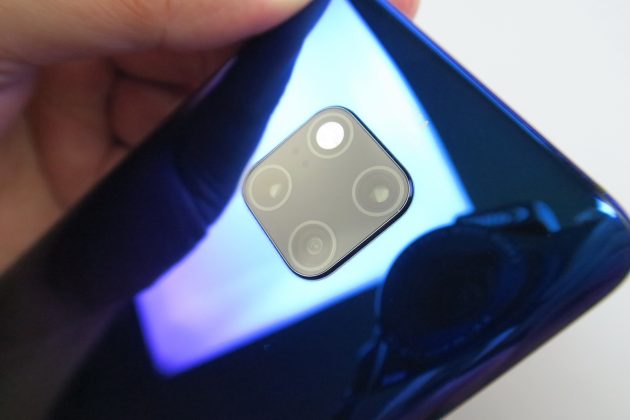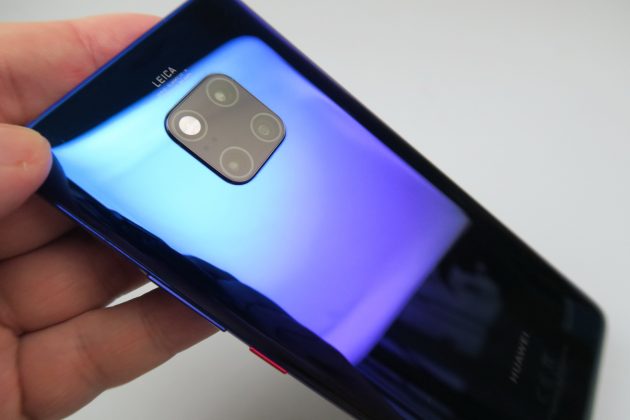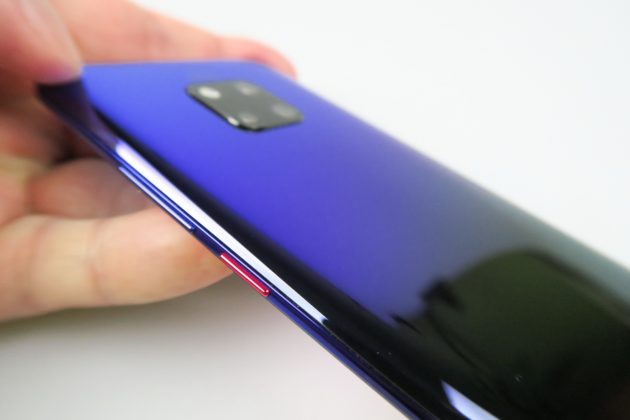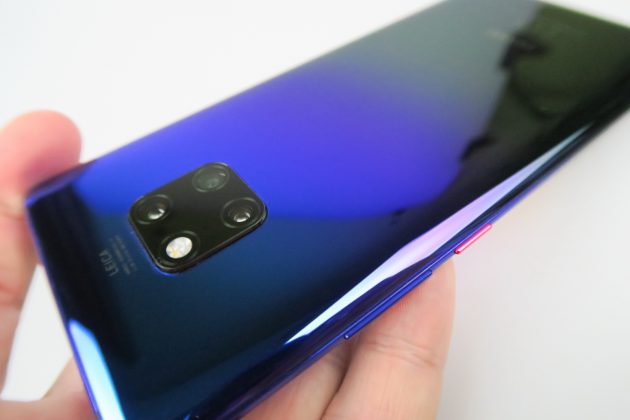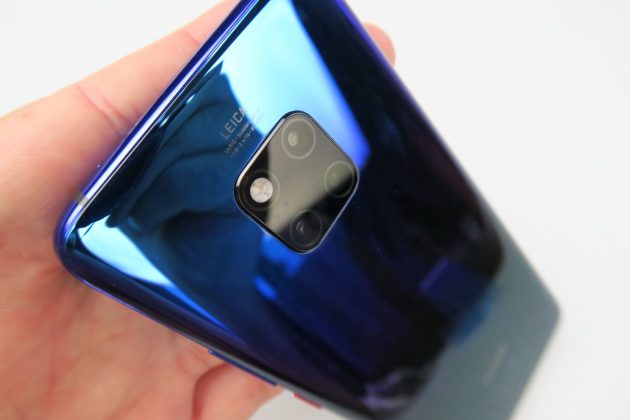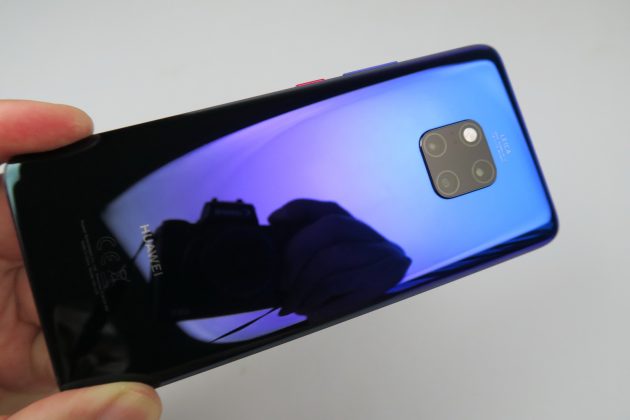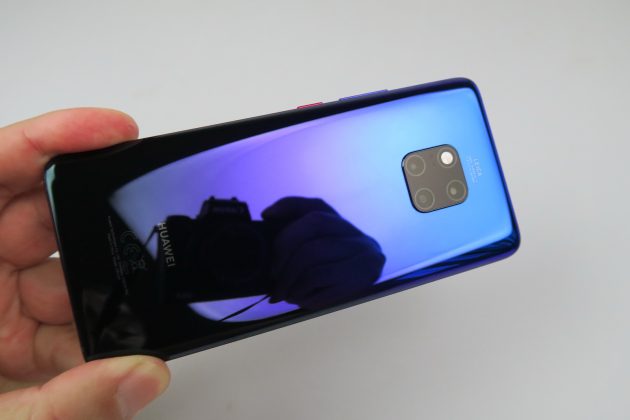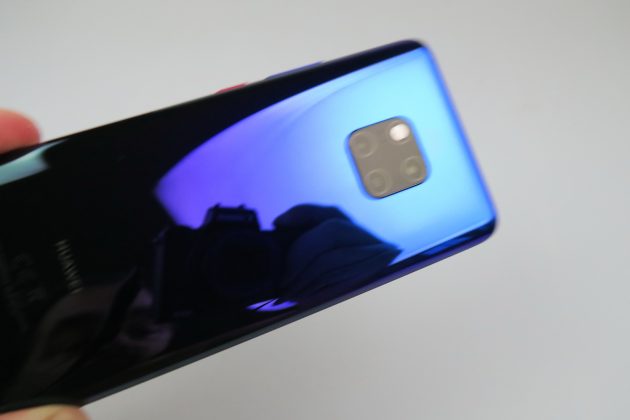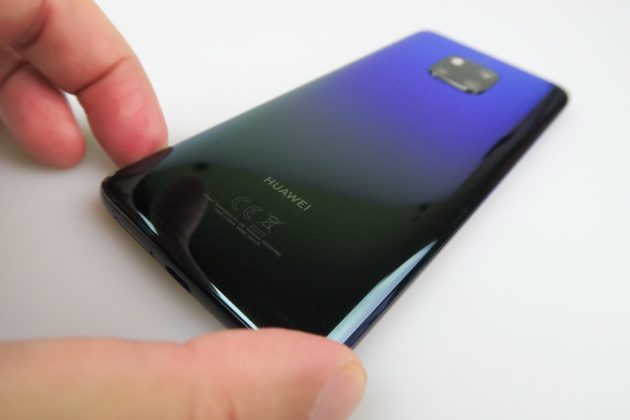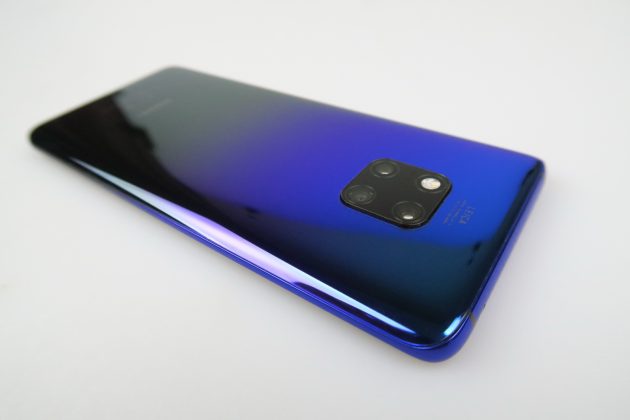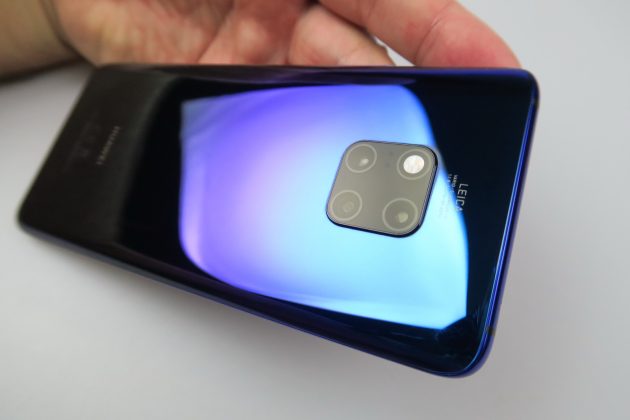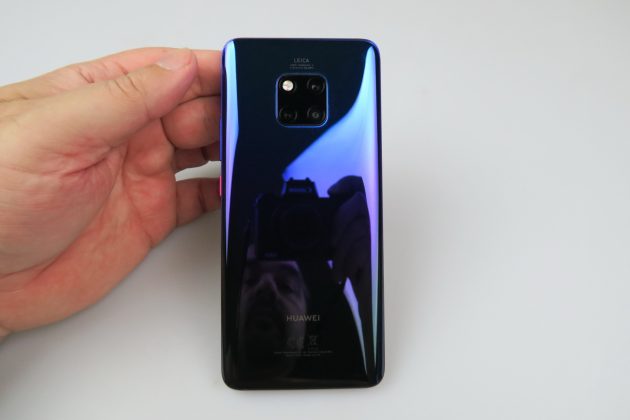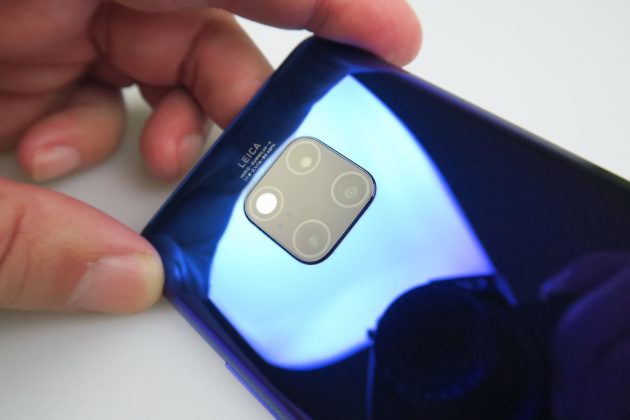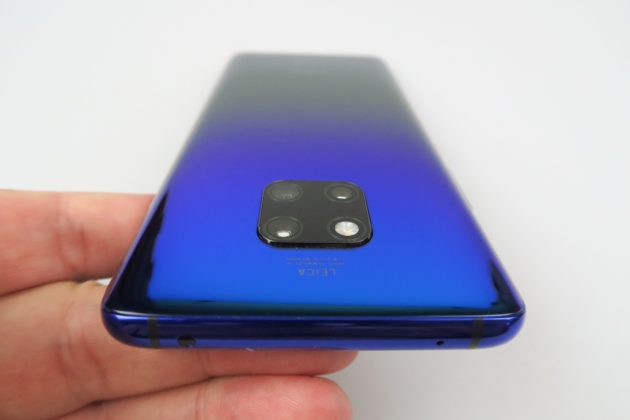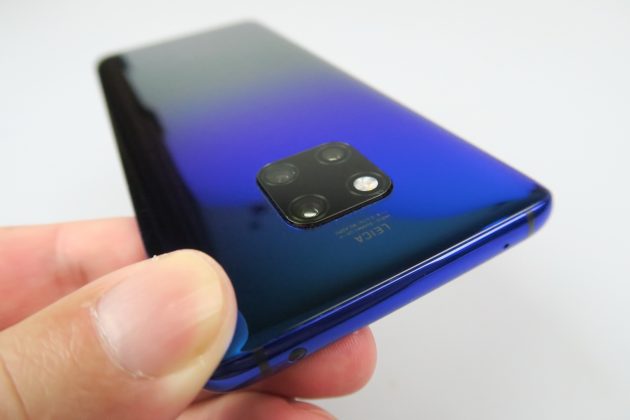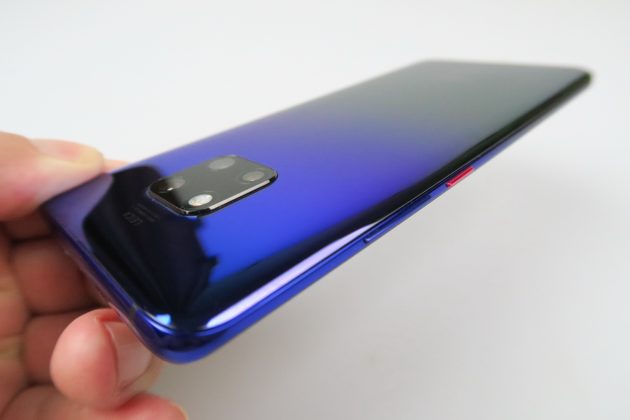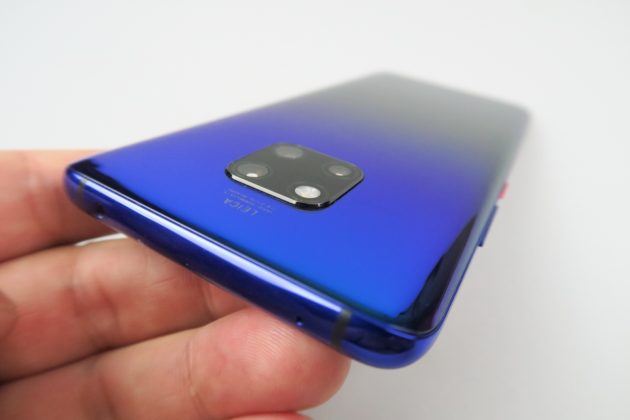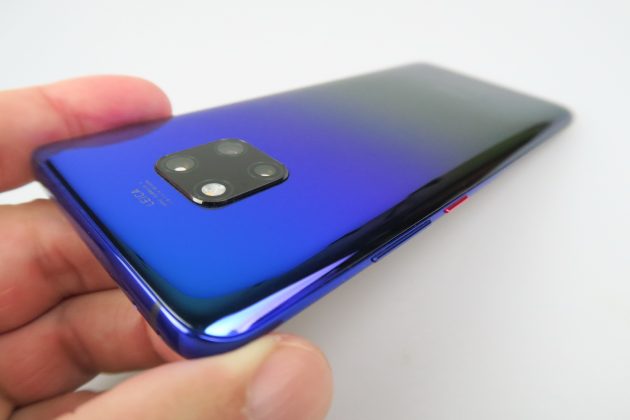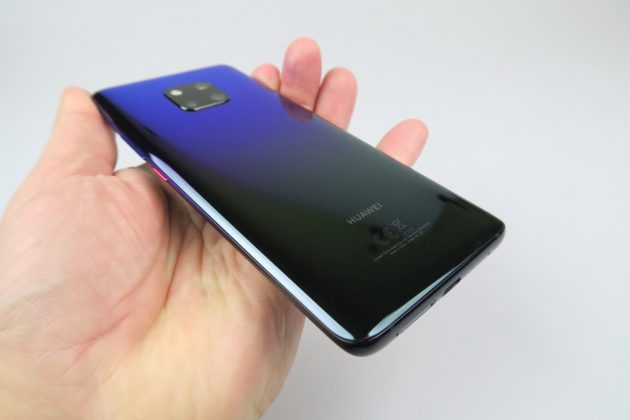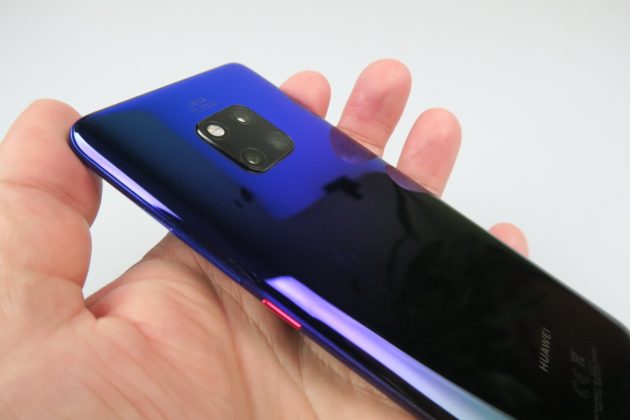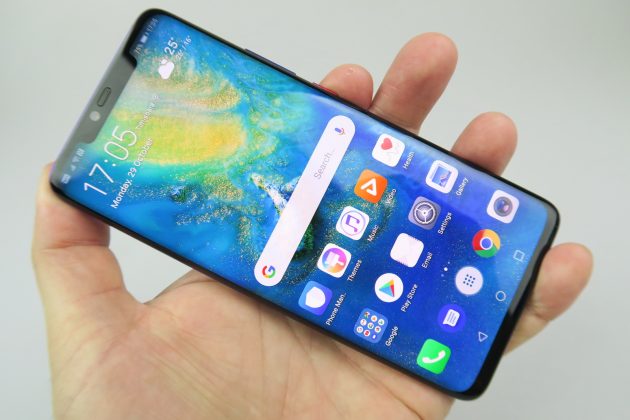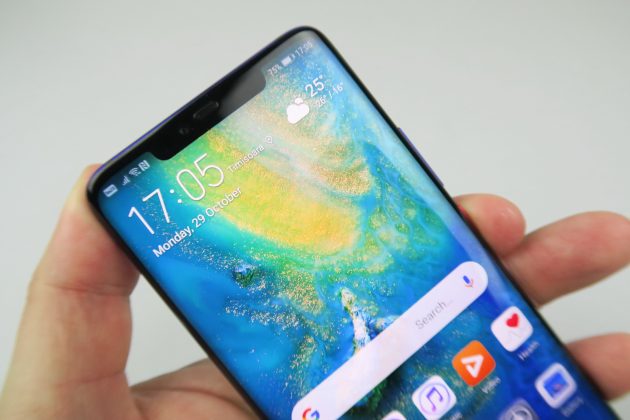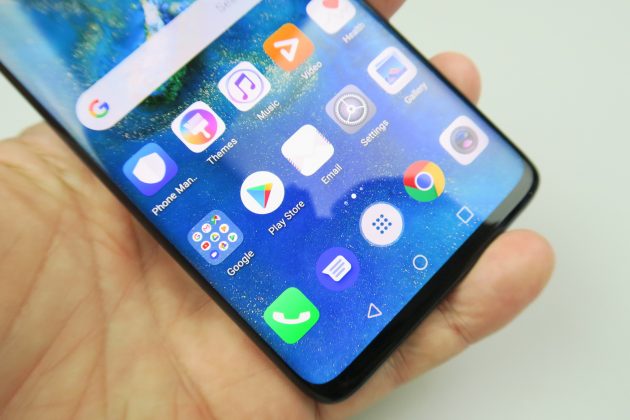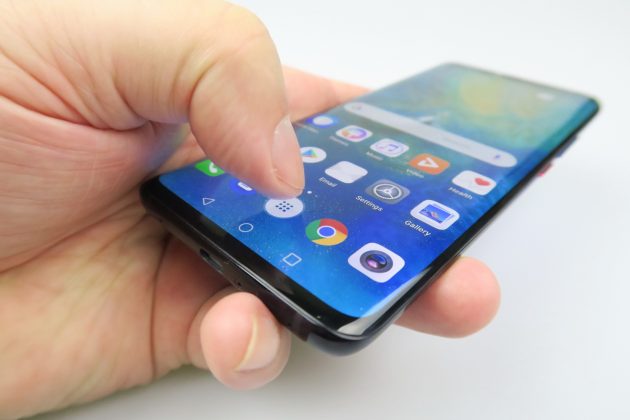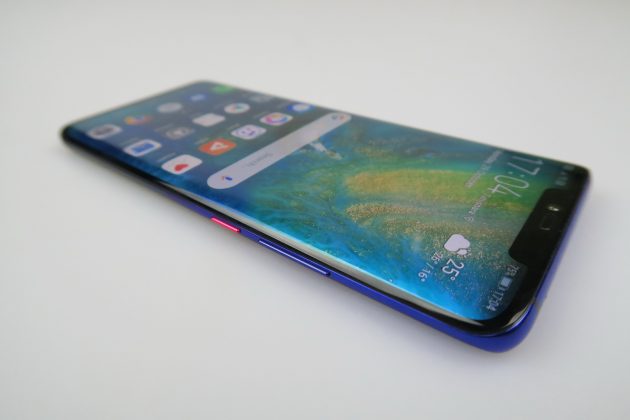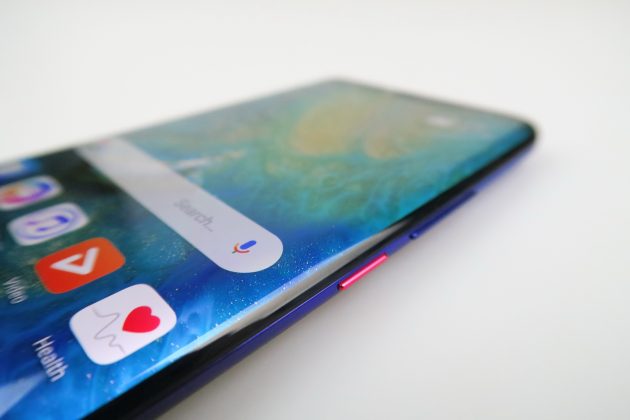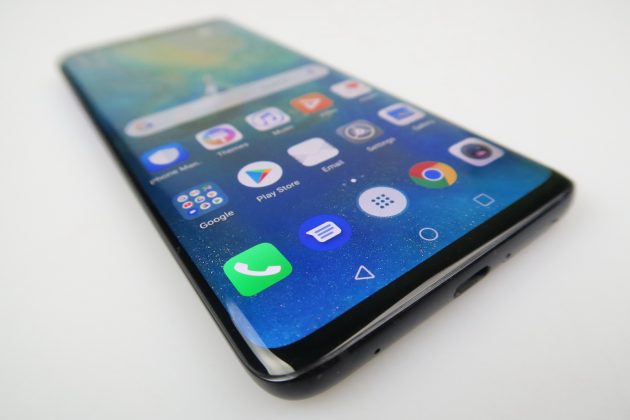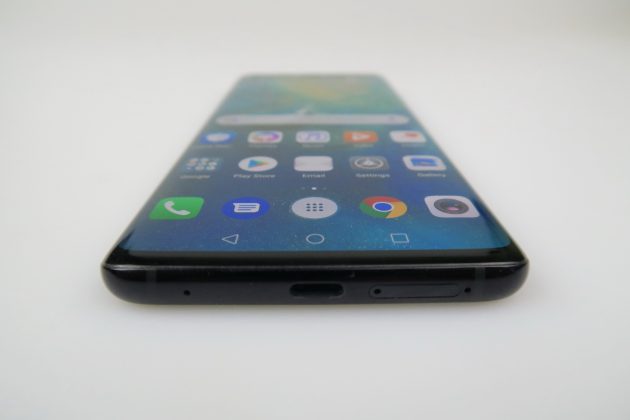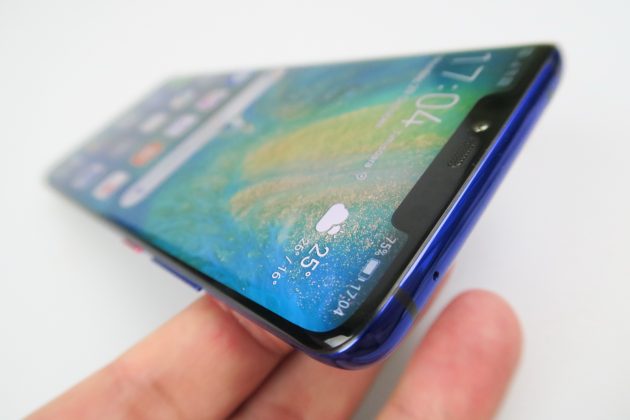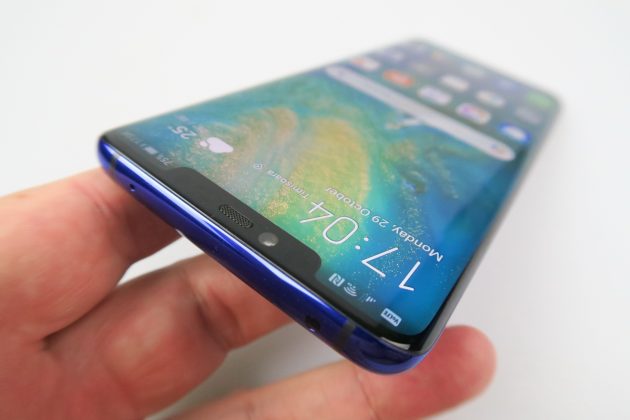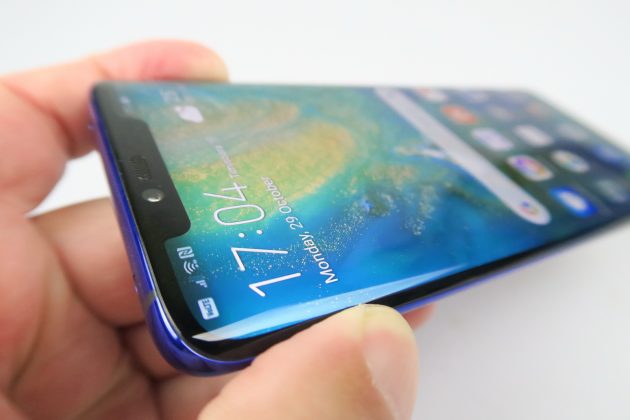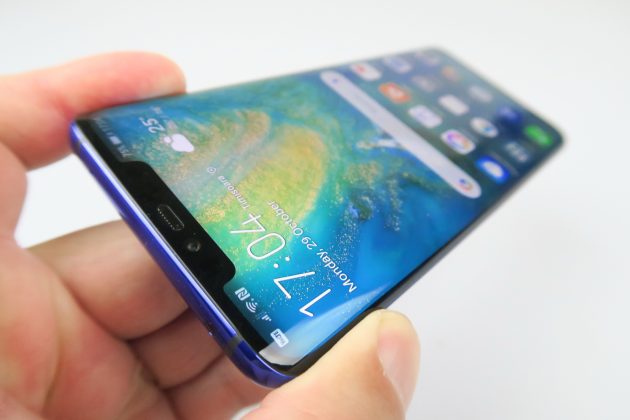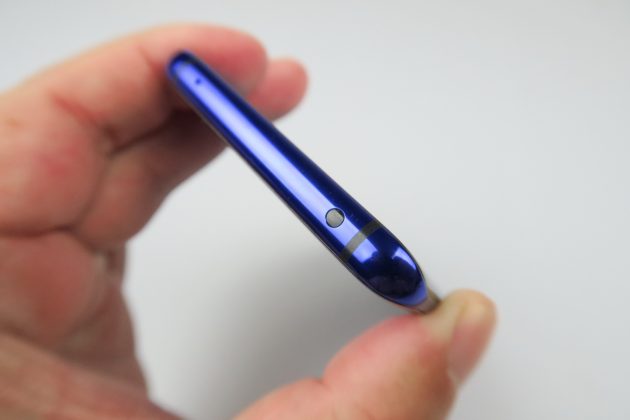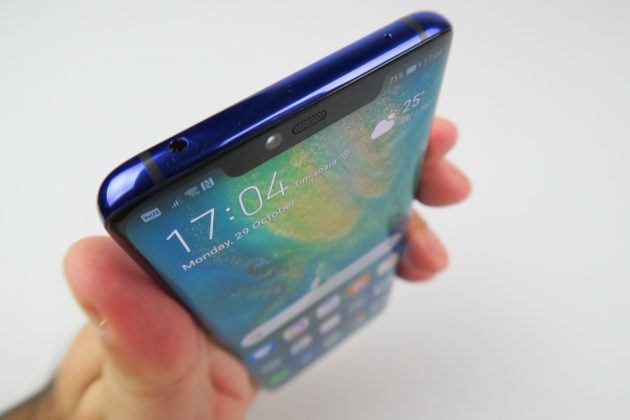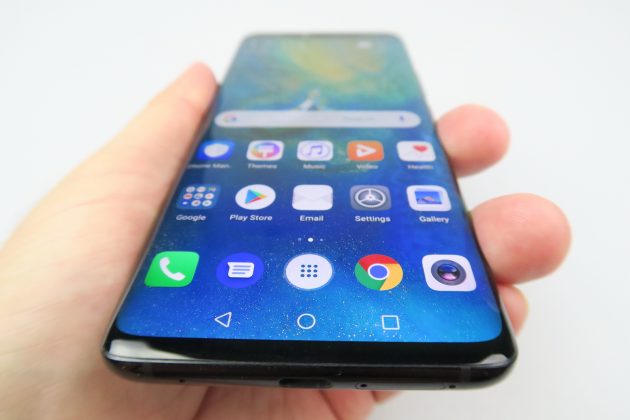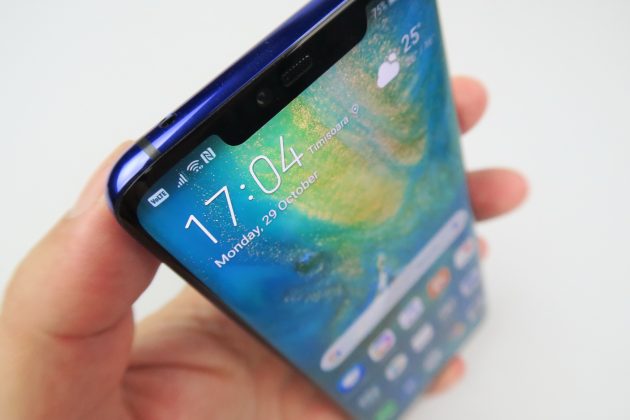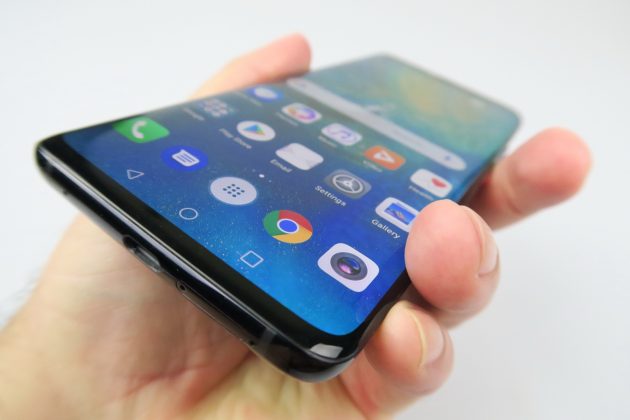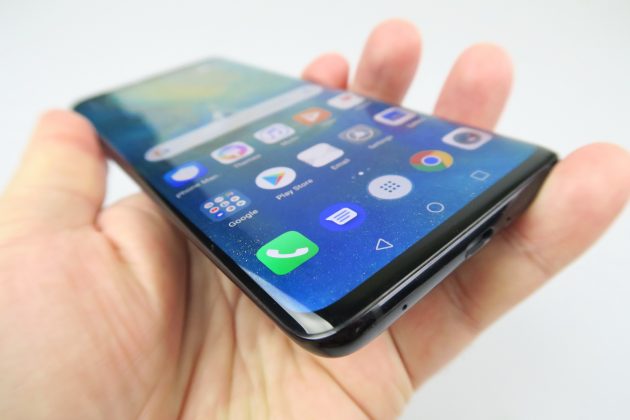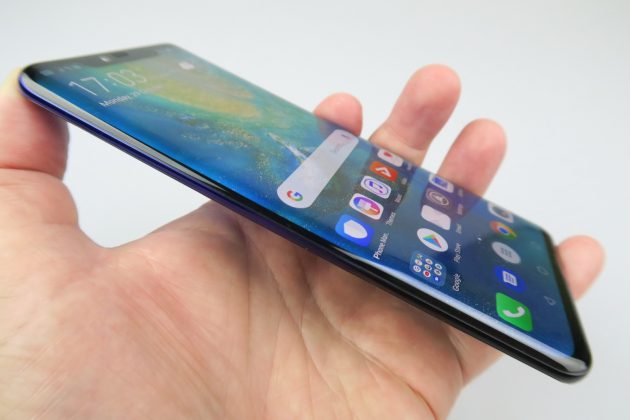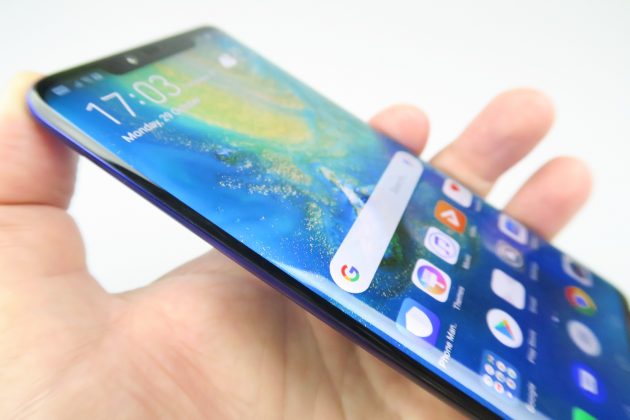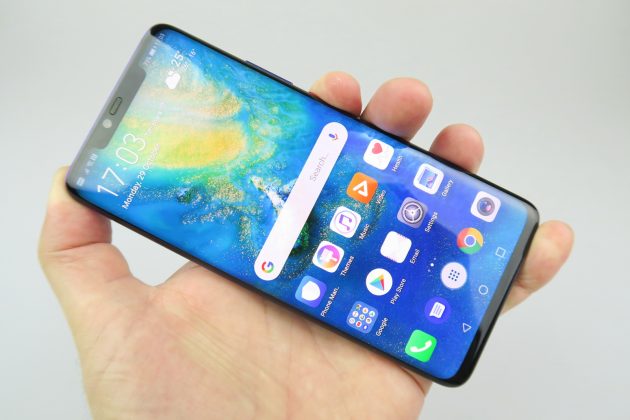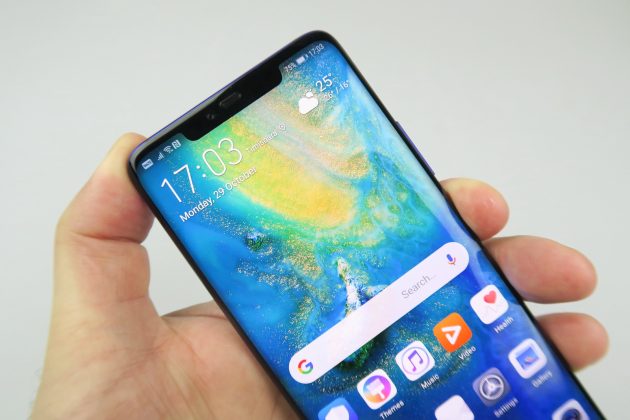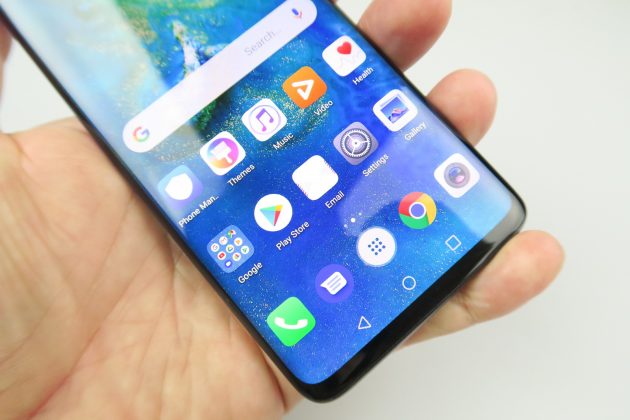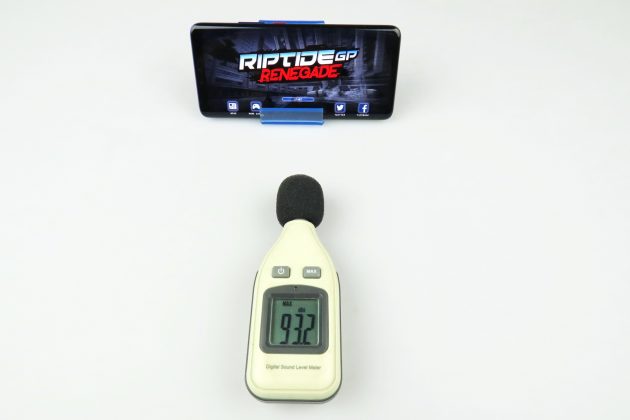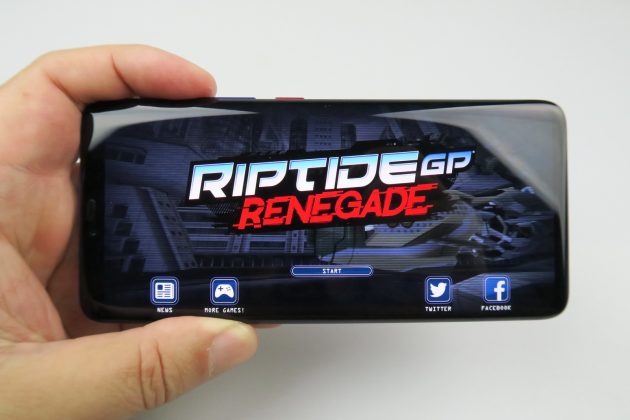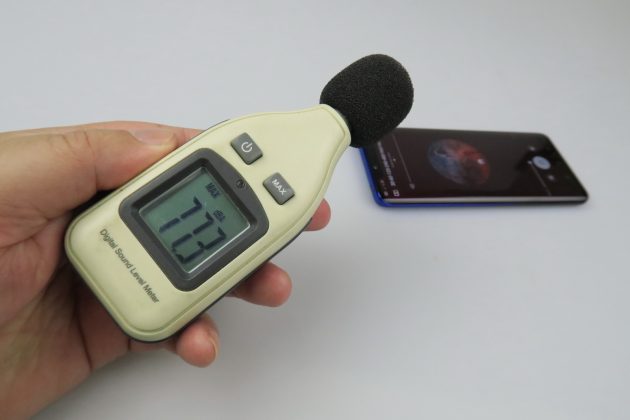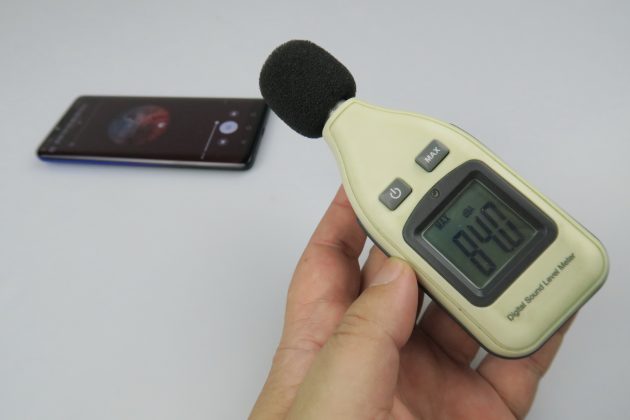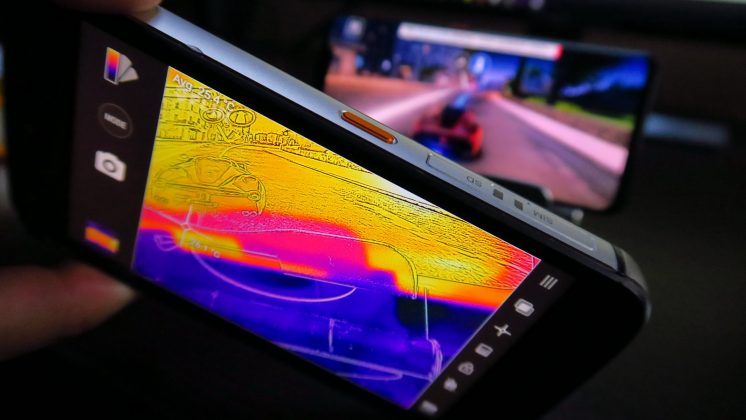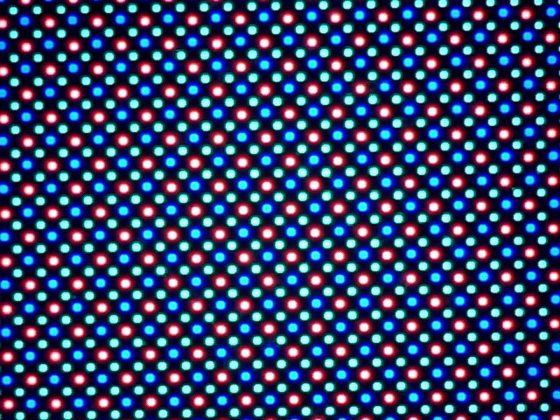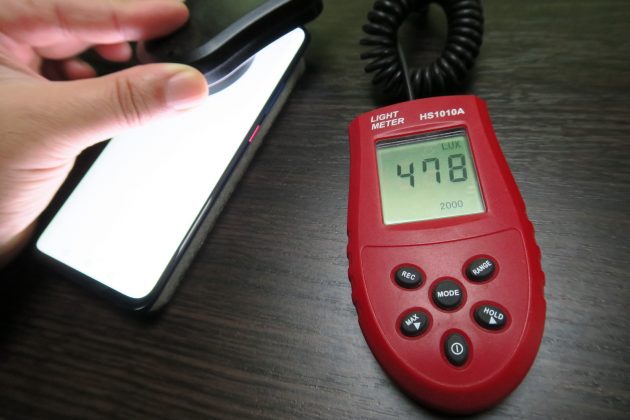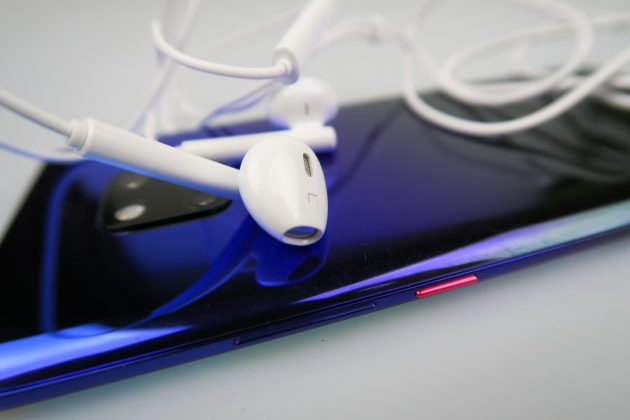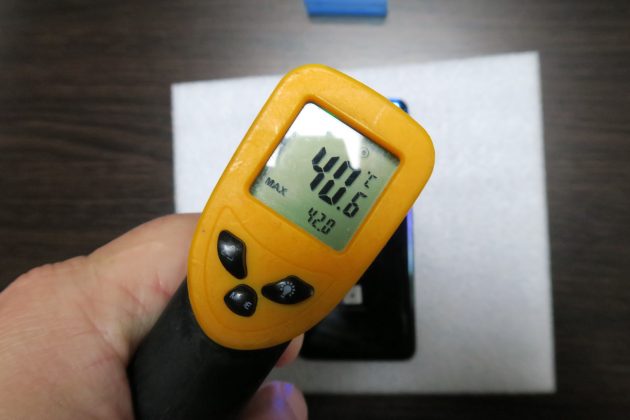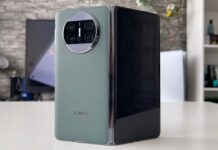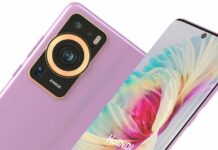Huawei Mate 20 Pro is going to be number one on a lot of top 10 2018 smartphone lists, I bet. That’s why it’s time to provide it with some late review coverage. We actually reviewed it last month, but only now got around to writing all of it. The device has the most beautiful back I’ve seen, an original new integration of the camera and it was announced on October 16th. It’s priced at around $1100 or so and it brings forth 3 back cameras and a lot of novelty.
It inaugurates the nano memory card, it’s the first in display fingerprint scanner phone we test, it’s got reverse wireless charging for the first time and it’s the first contact we have with a Kirin 980 CPU. The phone is available in Emerald, Twilight and Midnight Blue or Black and we reviewed it below.

Design
The handset has a curved glass back side and also curved glass at the front. It’s all beautiful 3D glass, joined together with a metal frame. The phone doesn’t slip and the grip was quite excellent. I did find the back to be a bit “fingerprinty”. The measurements are OK, between the 8.6 mm of the waistline and the 189 grams of weight.

Meanwhile the Huawei P20 Pro weighed 180 grams and measured 7.8 mm in thickness. Samsung Galaxy Note 9 is even more beefed up at 8.8 mm and 201 grams. There’s of course a notch, which has become the norm, plus we have a set of pretty comfy buttons. This is a pretty narrow device, with the same feel in the hand as the OnePlus 6. One hand use is also on the table and it’s pretty comfy.
Huawei Mate 20 Pro is a looker and it’s made of premium materials for sure. It’s IP68 certified and while many people did memes of the back camera, the square format grew on me in the end. It’s certainly not a deal breaker.
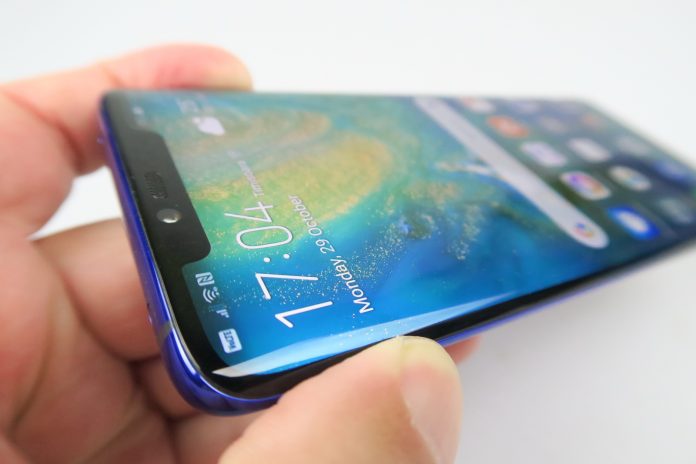
Display
Huawei Mate 20 Pro has a 6.39 inch display, with a lot of perks. It’s got DCI-P3 calibration, uses an AMOLED panel and offers a 3120 x 1440 pixel resolution, with HDR10 support and 19.5:9 aspect. The panel can be made by LG or BOE and we’ve all heard what problems are associated with the LG version, namely the green panel seen from a certain angle. In my experience this phone offers vivid colors, wide view angles and good contrast.
The brightness is high, the black is deep and there’s no problem with the green thing for me at least. Pixels have a Pentile Matrix arrangement, as seen under the microscope we typically use. We did a brightness measurement with a luxmeter and achieved 478 LUX units, which is just OK for a flagship. I’ve seen much higher on the latest iPhones for example.

The iPhone XS Max is much higher for example. At least it surpasses the Samsung Galaxy S9+, Nokia 7 Plus and HTC U11. There are better achievers, like the Huawei P20 Pro, iPhone X and OnePlus 3 even. Settings are rather generous and we’ve got brightness, Auto Brightness, Colors and Eye Comfort, with a Natural Tone and the option to get rid of the blue light.
There’s also a bunch of sliders for the color mode and temperature of the colors. You can set it to Normal or Vivid, but I’d go with Vivid to be honest. Color palette can also be tweaked and we can set it to cold, warm or default. Eye Comfort is also a thing, removing blue light. Text and display size can be set up too, plus there’s Smart Resolution and the option to set your own resolution to HD+, Full HD+ or WQHD+.
We’ve got a Simple Mode, Always on Display and full screen display. Of course you can hide the notch, in case you don’t like it. Overall a pretty solid screen, but I wish it were brighter.
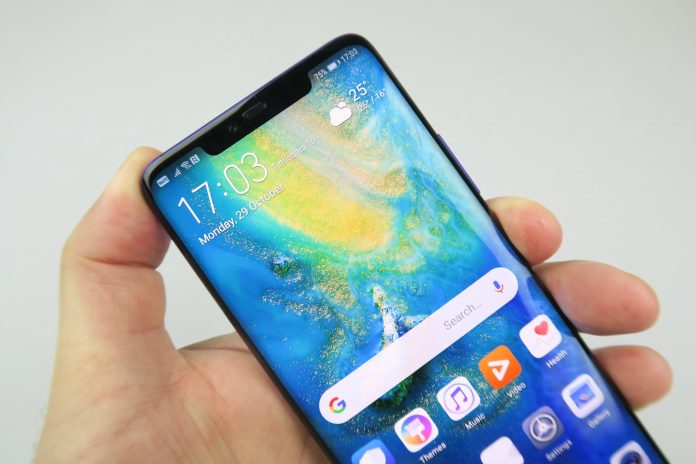
Hardware
Huawei Mate 20 Pro features the best of the best hardware that Huawei has to offer right now. The Kirin 980 is the best CPU on Android, also the first 7 nm one on the market. It’s an octa core chip with the Mali G76 MP10 GPU in the mix, with GPU Turbo 2.0. It promises 60 FPS graphics in at least 6 grams. We’ve also got a dual NPU for AI and premiere support for 2133 MHz LPDDR4X RAM.
Speaking of RAM, the device comes with 6 or 8 GB of RAM and 128 GB of storage. For expandable storage, we have the brand new nano memry card slot with support for up to 256 GB. There’s no lag here and the device can run any game like a champ, from Creative Destruction to PUBG, Fortnite and Asphalt 9. High FPS, great fluidity and no overheating were present.

We also did benchmarks, which was a pretty easy task, since the device was basically number one in most of them. In AnTuTu 6 we were on the first sport, easily surpassing the ASUS ROG Phone for example, plus the iPhone X. In AnTuTu 7 we were second placed, only beaten by the iPhone XS Max by 47k points. We beat the ROG Phone and Galaxy Note 9 though.
GeekBench 4 Multi Core had us above the ASUS ROG Phone, OnePlus 6 and Galaxy Note 9, but also below the 2018 and 2017 iPhones. Slingshot was a bit of a surprise, placing the Mate 20 Pro on the fifth spot, above the Xperia XZ3 and HTC U12+, or the Galaxy Note 9 Exynos, but below the ASUS ZenFone 5z and OnePlus 6 even. It’s still a very powerful machine.
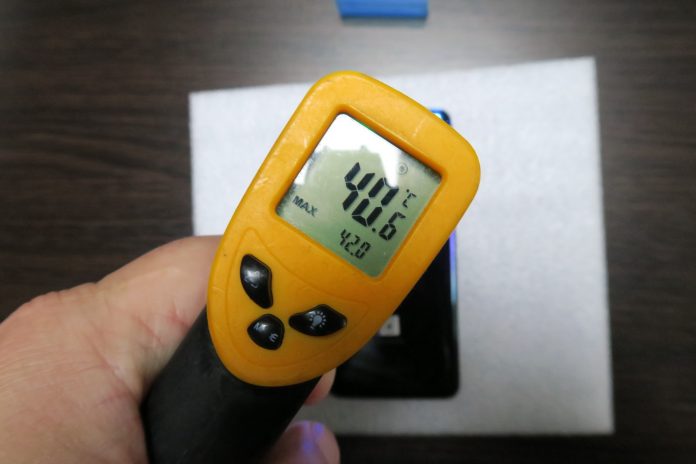
It reached 36.3 degrees Celsius during charge, but also 42 degrees in benchmark, so there’s a bit of overheating here. In games it was just 35 degrees, so I suspect the overheating comes only when cheating in benchmarks basically. The heatmap was also rather OK and heat dissipation was efficient.
Battery
Huawei P20 Pro was a battery beast and we expect no less from Huawei Mate 20 Pro. The device’s 4200 mAh battery sure sounds fine, even coming frm the 4000 mAh of the Huawei P20 Pro. There’s also 40W Super Charge and 15W wireless charging. Then we have the promise of AI mixed up with the battery usage and the promise of reaching 70% battery after 30 minutes of charging. Plus you can charge other devices via wireless.
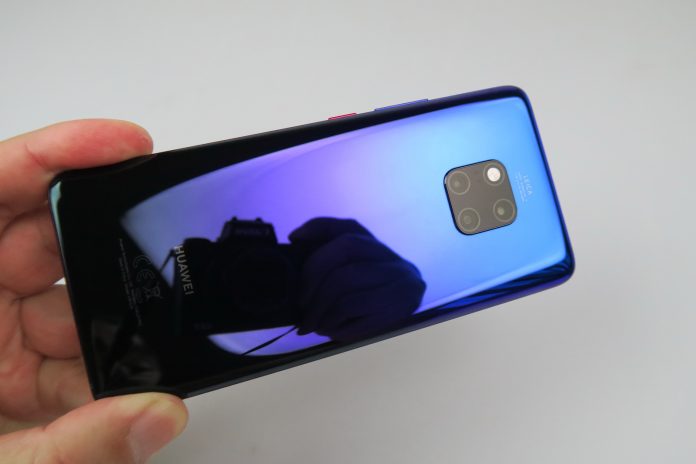
That one actually works pretty slowly and it took about 10 minutes per 1% of Galaxy S9+ charge. We go to the actual battery life and you should know we achieve 12 hours and 41 minutes of video playback, which is rather solid. It surpasses the Galaxy S9+ and iPhone 8 Plus, as well as the iPhone X. We also scored below the Huawei P20 Pro (15 hours and 37 minutes) and Galaxy Note 9.
When it came to continuous usage, we got to 8 hours and 51 minutes, which is underwhelming for a flagship. It’s not bad, don’t get me wrong, but it’s no champ. I’ve heard many people reaching more than one day of use and I can also say I got more than the benchmark shows. I’m guessing that the AI thing may do its thing over time.
With this PCMark result we went past the Xperia XZ2, Pixel 2 XL and Nokia 8 Sirocco, but we scored below the ASUS ROG Phone and Huawei P20 Pro (11 hours and 57 minutes). Charging is done in a mere 53 minutes, which is simply superb. After 15 minutes of charging you’re already at 38% and after 30 minutes you’re at 75%.
Settings include classic things, like Optimize, Performance Mode, Power Save Mode, Ultra Power Save Mode and WiFi on in sleep mode. You can also darken the UI and change screen resolution to save some juice. Overall a pretty good battery, but I have mixed feelings about continuous usage.

Multimedia
Huawei Mate 20 Pro has dual speakers, one at the top and one at the bottom. The bottom one is rather unusual, since the sound comes out of the USB Type-C port. It’s a stereo setup and by the way the Huawei P20 Pro also had a setup like this. The listening experience featured lots of vibration of the case, plus a very warm voice and a solid bass, plus nice highs.
The speaker can be covered easily in landscape, I’d say. There’s also Dolby Atmos in the mix and we’ve got EQ modes for the speakers, like Smart, Film and Music. I found the sound to not be very uniform and stereophony isn’t very equal. Bundled headphones look like Apple EarPods clones and the predecessor also had similar accessories.

They’re rather comfy, but not very loud. We did some decibel tests and achieved 84 dBA at the bottom and 77.3 dBA at the top. It beats the Huawei Honor 10, Pixel 2 XL and Huawei Mate 10 Pro, but staying below the Huawei Mate 9 and iPhone 7. We also tried out Riptide GP Renegade and achieved 93.2 dBA, which is not very impressive, seeing how many 100 dBA handsets I’ve seen lately.
It’s better than the Huawei P10 Plus and Mate 9 Pro, or the Xperia XZ1, but stayed below the Huawei P20 Pro (98.7 dBA) and iPhone 8. I expected more to be honest. This is very far from what I’ve seen on the ASUS ROG Phone for example.
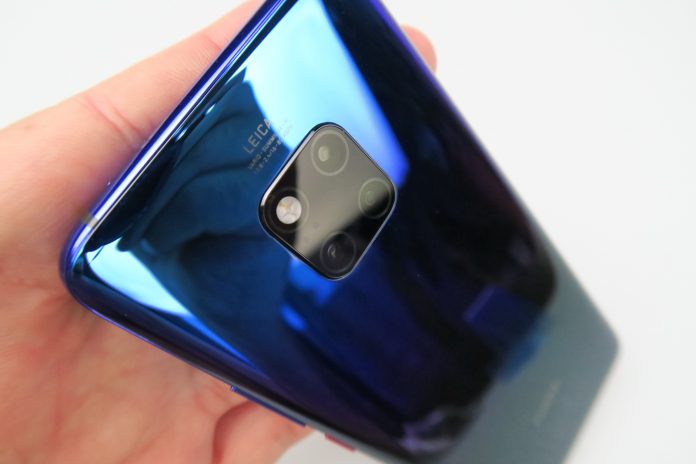
Camera
Huawei keeps Leica technology in the mix, this time on a triple camera arranged in a square. The setup is the following:
- 40 megapixel, wide angle camera, F/1.8
- 20 MP, ultra wide angle camera, F/2.2 (in lieu of Monochrome camera from Huawei P20 Pro)
- 8 MP, telephoto camera, F/2.4 aperture, 3x optical zoom, 5x hybrid zoom
There’s also laser focus, PDAF and contrast focus, plus a dual LED flash and AI. Upfront we find a 24 megapixel camera for selfies, with F/2.0 aperture and the AI is able to discern between 1500 scenes. My experience with the camera involved very fast focus and fast picture taking, new options for the Portrait mode and also some new filters, like Stained Glass. Not a big fan of theirs to be honest.
There’s Night Mode here, Aperture, AI Zoom (keep video centered and LG has something similar on LG G7), Monochrome and 3D Panorama. There’s a special Underwater capture mode, Light Painting, Filter, Documents and Slow Motion, as well as AR Lens. Of course you can still do moving pics and choose colors for the capture, like Standard, Vivid and Smooth.
Master AI is still here, optional of course and overexposing the pics less than on the Huawei P20 Pro.

Moving on to the day time gallery, we took a gigantic number of shots, in areas like Timisoara and Bucharest in Romania, but also Portsmouth and London, UK. For starters we also did a comparison with the iPhone XS Max and the Huawei came out on top. It’s got great dyanmic range, it’s able to capture a perfect sky and provides fantastic zoom abilities.
It surpasses the Galaxy Note 9, iPhone XS Max for sure in this area. Bokeh was great, with both the selfie and main camera, although once again I don’t like its new filters. Colors are much better and more realistic than on the Huawei P20 Pro and there’s no more overexposure. Still Galaxy Note 9 and iPhone XS Max feel a bit closer to human perception.
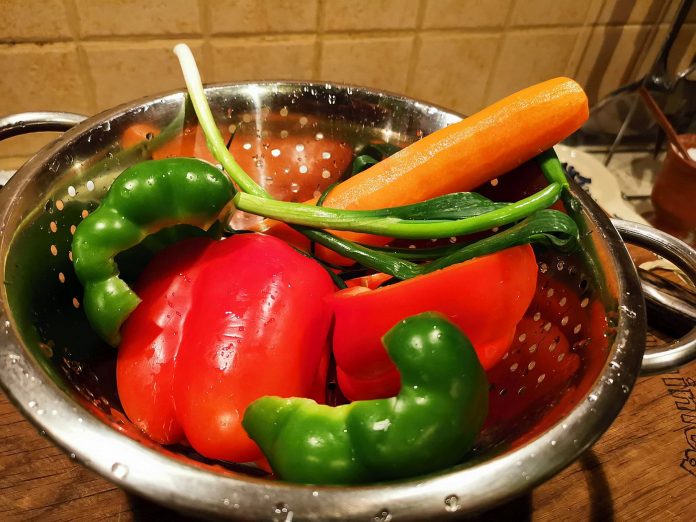
I loved the texture of the veggies I caught indoors when cooking and found the zoom to be amazing. I actually used this handset as a journalist tool during the Samsung Galaxy A9 (2018) launch event and even did a hands on with it as may camera. I did notice some problems with the focus in closeups, as it doesn’t “take” as fast as I’d want it to.

There’s a tendency to neglect the smaller macro object in favour of the background. Also, there were times when the hues of red were slightly messed up. Selfies were perfect in my book, with lots of details, I could see the pores, each thread of hair and even the background was OK. The beard, clothes, everything was just as I saw it in real life.
Nice landscape shots, as we return to the back camera, with a large amount of details.

Panorama was reasonable, at 9792 x 2304 pixels. We also did some food shots, but they were rather absurd, since the colors seemed to be quite off. The greens were exaggerated, but texture of the meat was spot on. I feel that overall we’re getting a 15% bump from the Huawei P20 Pro in quality, overall. I loved the Portrait shots, perhaps the best on Android, but find the new filters and options associated to Portrait being useless.
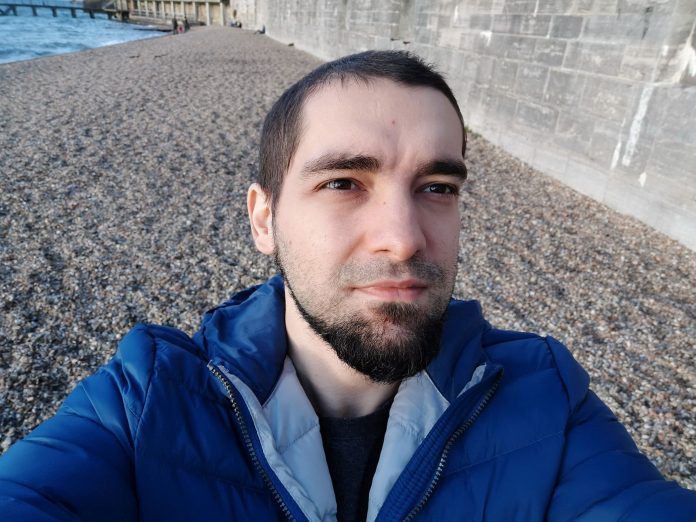
There are only two flaws here basically: it’s hard to focus properly on closeups and some hues of red are rendered wrong. Otherwise, it’s all perfect. Moving on to the low light shots, we had here a duel with the Apple iPhone XS Max. We pitted the two devices together and it was a very tough battle. The Huawei Mate 20 Pro has better colors and faces panel lighting from the shop fronts better.
Improved water texture is also here, plus more natural yellow lights. A better equalized light for that pharmacy logo is also in the mix. I loved the perfect clarity and the way day turns into night, not only with Night Mode, but also with regular bright shots. I would say it’s not the brightest phones out there, since Pixel 2 XL and Galaxy S9+ are brighter, but it’s much clearer.
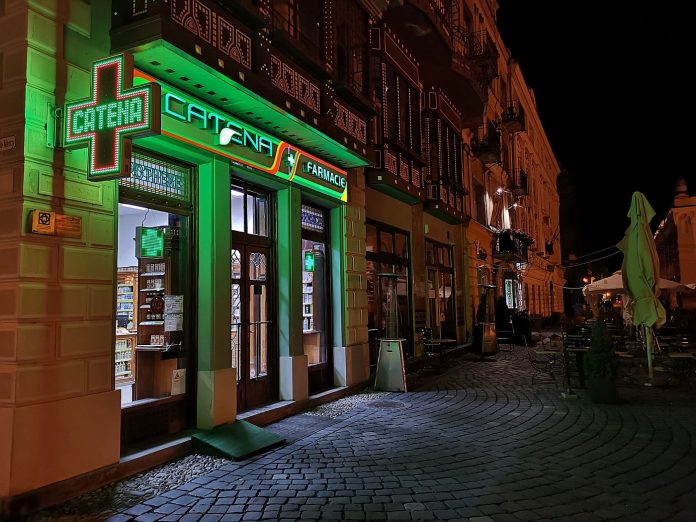
Overall, it feels like number 1 in 2018, till we get to test the Pixel 3. Judging by the latest DxOMark tests, I’d say the Pixel 3 drops below it. I even loved the zoom in low light conditions, the halos were OK and the wide angle capture had some weird red hues, that felt a bit extra compared to the regular experience.

They were also more curved and they looked like a midrange affair, not exactly high end. We registered the best statue zoom ever, since I’ve been testing handsets and zoom onto the same statue. Flash was perfect, not drowning the image with too much white and I also loved the fact that you don’t lose too many details when zooming in.
It’s not the brightest camera, but it’s the best for sure.
The video capture involved great clarity, perfect zoom (look at that ostrich) and in general the captures done at the zoo were great. If you look at the bear fur texture and the feathers of the ostrich, you’ll see what I mean. We also liked the dynamic range and the lighting in all shots, even in the troublesome ones with a powerful 90 km/h wind and sun coming out of the clouds on the shore of Portsmouth.
The microphone handles the wind in a pretty OK manner and it also does panning without artifacts, motion blur of weird exposure changes. The exposure change happens in a discrete fashion. Stabilization was very solid by Huawei standards, since usually Huawei phones mess that up. It’s probably the best I’ve seen on their phones.
I still wonder why we don’t have 4K 60 FPS capture supported here. Anyway, the zoom was efficient, albeit with some weird focus at higher levels and I loved the texture of the send in the shore videos. If you look at the 4K clips on the shore, you’ll feel as if they were part of some movie, or documentary.
The selfie video is yet another top 3 material, or perhaps the best of 2018. The background, the foreground, they’re perfectly clear, realistically colored and always in focus.
The 60 FPS vid is a bit overexposed, but even there things are OK. No more burn, no more weird colors from the Huawei P20 Pro, it’s everything allright right now. The green hues are OK, but the sky feels a bit white, particularly in the 60 FPS videos. I found it annoying that when zooming out back from the 5X zoom you will be dragged into 0.6x of the wide angle camera and mess up the videos.
Avoid getting into the wide angle camera, since it totally spoils your clips and I consider it a bug, so be careful with the zoom out. Overall, while this is a record for Huawei, it’s a bit below the iPhone XS Max and Galaxy Note 9. The best things about videos? Microphones, selfie video and stabilization.
In low light conditions we had 27 or 28 FPS and sadly a flakey and shaky picture. I mean the lighting is OK, colors spot on, halos OK size and zoom fine. However, stabilization pales a bit. The microphone catches everything, the panning was fine with no surprises and there are some reflections here and there, extra ones.
Looking back at the Huawei Mate 10 Pro low light video (which was quite good), I can’t say we’re getting a major upgrade for low light filming, maybe some extra brightness. The same goes for Huawei P20 Pro night time video capture. The Super Slow Motion videos are not clear, they need a lot of light and they’re very hard to focus properly. They’re also just HD, compared to Samsung’s Full HD, so thumbs down.
Browser/ Input
We opted for Chrome here and while we were below Safari in benchmarks, the browser had a pretty OK speed overall. Input is done via Swiftkey and I’m not a very big fan of it, or its spacing.
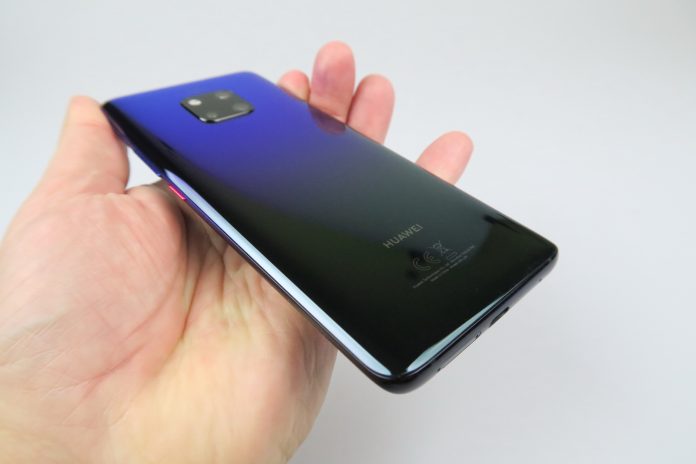
Connectivity
It would be expected that Huawei would offer the latest connectivity options, seeing how they provide the best and latest connectivity equipment, give or take a spying scandal or two. Huawei Mate 20 Pro packs an USB Type-C port, infrared connectivity too, used to control TV sets, set top boxes and more. There’s also GPS, a high precision one actually, with dual frequency, L1 and L2.
The device is available in dual SIM or single SIM versions and comes with AGPS, Glonass, Beidou, Galileo and QZSS. There’s also WiFi a/b/g/n/ac, Bluetooth 5.0 and NFC. USB Type-C is of the 3.1 variety here and there’s sadly no FM radio. Calls were loud and clear and on the 4G front we had support for LTE Category 21, after last year Mate 10 Pro inaugurated LTE Category 18.
There’s also the feature that rivals the Samsung DeX and lets you turn the phone into a PC replacement, by simply hooking it up to a monitor, keyboard and mouse. It doesn’t require a special accessory though. We also did a SpeedTest and achieved very high values, like 253 Mbps in download on 4G and 67 Mbps on upload. On WiFi we got as high as 499 Mbps for download, which is basically the theoretical limit promised by our provider.
There’s also 25 Mbps for upload.

OS, UI, Apps
Huawei Mate 20 Pro runs on Android 9.0 Pie, with EMUI 9.0 on top. It has some lighter hues compared to the predecessor, but overall the change from Huawei P20 Pro isn’t huge. The leftmost homescreen is meant for the Google feed, which was to be expected. Multitasking is still done with cards and you still swipe up to close them.

There’s also split screen in the mix. Pinching the homescreen results in accessing options like Wallpaper, Widgets, Transitions, plus home screen settings. You can mess around with layouts, badges, the home screen loop and more. Swipe down and you access the notification area and the Quick Settings, both pretty well spaced and organized.
Even a screen recorder makes the cut in the Quick Settings and it’s welcome. Notification dots are also available. Settings include options for wireless projection, which is the desktop feature mentioned above (turn the phone into a desktop replacement). There’s also App Twin, App Assistant, Game Acceleration, Storage Cleaner and Digital Balance.

This is Huawei’s take on Parental Control and Digital Wellbeing. There’s also One Hand UI, Motion Control (gesture control), voice control and gloves mode. You can also choose system navigation in the form of a navigation dock or gestures. Security is taken case of by face unlock, which can happen directly, or preceded by a swipe (slide to unlock). The unlock is fast and even happens in the dark.
The fingerprint scanner is embedded within the screen and it’s rather slow when it comes to unlocking the device. You also need to keep it pressed hard, which already feels old nowadays. It’s only a small area that actually senses your print, on account of having an optical mechanism. We also have a Password Vault and AI Powered gallery here.

As far as the preinstalled apps are concerned, I counted 49 of them. Some of them feel like bloatware, such as Booking.com, eBay or Netflix, but there’s also Notepad, Facebook, Health, Instagram and the useful Phone Manager, with its own flavour of Avast for antivirus duties. Smart Remote and Translator round up th elist.
Verdict
Pros:
- superb looks
- comfy
- highest powered Android phone of 2018
- perfect selfies
- best pictures in town/ best camera
- good display
- uber fast charging
- OK audio
- perfect connectivity
- solid face unlock
Cons:
- video capture could be better especially low light
- closeup focus problems
- slow fingerprint scanner
- not complementary speakers
- USB Type-C speaker idea is not very good
- I’m not sold on the idea of a nano SD card
Huawei Mate 20 Pro has several gold medal attributes in 2018: selfie photos, looks (Twilight back is gorgeous) and camera quality in general. It takes the best pics, but its videos are more like podium stuff, maybe even fifth spot. It’s got very fast connectivity, incredibly, gigantically fast and also fast is the charging, once again number one on the market.
Basically, you’re buying this for speed, like a sports car and for looks, also like a sports car, plus the kickass camera. Sexiest Android phone and best camera by far. It even feels like an impressive bump up from the Huawei P20 Pro if you can believe it, even though that one’s battery was superb.
You can buy the Mate 20 Pro here.



